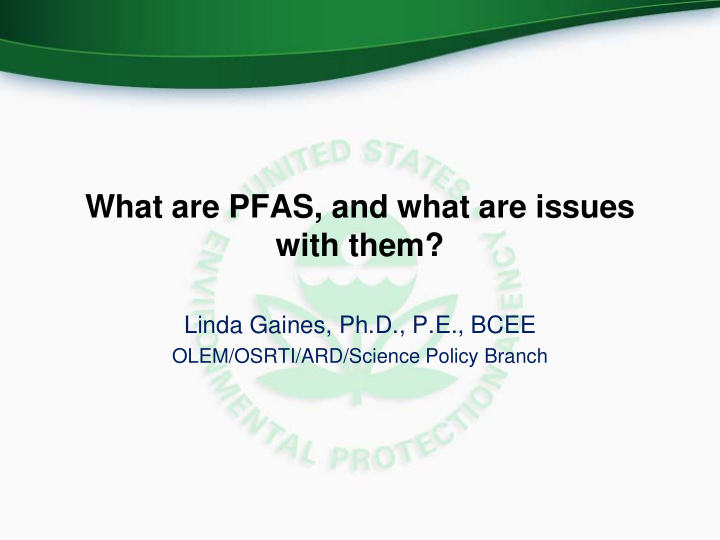



What are PFAS, and what are issues with them? Linda Gaines, Ph.D., P.E., BCEE OLEM/OSRTI/ARD/Science Policy Branch
Per- and Polyfluoroalkyl Substances • Group of thousands of chemicals – Subgrouped by functional groups – Most subgroups have range of chain lengths • Highly fluorinated • Highly resistant to degradation • Highly mobile • Varying (and unknown) levels of toxicity 1
PFAS • Perfluorotetradecanoic acid • Perfluoro(2-methyl-3-oxahexanoic) (PFTreA) acid (GenX) • Perfluorohexanesulfonic acid (PFHxS) • 4,8-dioxa-3H-perfluorononanoic acid (ADONA) • Fluorotelomer sulfonic acid 8:2 (FtS 8:2) • 8:2 Fluorotelomer phosphate diester (8:2 diPAP) 2
What are PFAS used for? PFAS are used in a wide variety of industries and commercial products for their valuable properties, including fire resistance, dust suppression, and oil, stain, grease, and water repellence. Fire fighting foams (AFFF) Dust suppression for chrome plating Food surfaces (Teflon) Electronics manufacturing Polishes, waxes, paints Oil and mining for enhanced Stain repellants on carpets and recovery upholstered furniture Performance chemicals Cleaning products (hydraulic fluid, fuel)
Overview of Potential PFAS Universe • Industries: • Waste disposal – Metal plating – Unlined landfills – Plastic and textile – land with biosolids coatings application – Chemical and plastics • AFFF users: manufacturing – Airports, train yards, etc. – Car washes – Fire training areas – Chemical refineries
PFAS Releases • Contamination routes vary – AFFF usage, testing, storage – groundwater, soil, wastewater – Biosolids application – soil to groundwater – Landfills – leachate to groundwater or wastewater – Manufacturing – wastewater and air deposition 5
PFAS Releases • PFAS found at sites: PFCA C4-14; PFSA C4-10; FtS 4:2, 6:2, 8:2; PFOSA, NEtFOSAA, NMeFOSAA • Media affected: – Groundwater water levels up to 2,000 µg/l – Soil levels up to 36 mg/kg – Landfill leachate 5.3 µg/l • Biota: fish, deer, honey 6
Toxicity Values and Health Advisories • Reference dose (RfD) for PFOA and PFOS is 0.00002 mg/kg/d – Lifetime Drinking Water Health Advisory is 70 ppt – HA is based on sum of both PFOA and PFOS concentration • OW Oral Slope Factor of 0.07 (mg/kg-day)-1 for PFOA, but RfD is risk driver • PPRTV RfD for PFBS • Draft ATSDR MRL for PFOA, PFOS, PFNA, and PFHxS • Various state toxicity values and advisories
Current Analysis Methods • Method 537.1 for 18 PFAS in drinking water • ASTM Method 7979 single-lab validated for PFAS in non-potable waters using direct inject • ASTM Method 7968 single-lab validated for PFAS in soils using direct inject 8
Analysis Methods in Progress • Draft SW846-8327 direct inject method for 24 PFAS in non-potable waters • Draft SW846-8238 solid phase extraction isotopic dilution method for 24 PFAS in non- potable waters and solids • Draft direct inject method for 24 PFAS in soils 9
Sampling • PFAS are ubiquitous so precautions must be taken to avoid contamination of samples • Existing wells may have PFAS leaching components which can cause contamination • Consideration needed of personal care products and clothing for potential contamination 10
Cleanup Challenges • Since PFAS are not CERCLA hazardous substance – cost recovery under CERCLA is not available – CERCLA authorities can be triggered if PFAS release or threat of release presents an imminent and substantial danger to public health or welfare (contaminant or pollutant) • No federal MCLs • Numerous states have derived different advisories and cleanup levels
Cleanup Challenges • Final toxicity information only for PFOA, PFOS, and PFBS • EPA Method 537 used for drinking water but no current multi-lab validated methods for other environmental media
Cleanup Challenges • Dispersion potential differs by type and length – Shorter seem to migrate faster – Migration depends on carbon content of soil – FtOH are volatile, but others can be dispersed by air as particulates • Ecological uptake differs – Animals seem to bioaccumulate sulfonates – Plants seem to uptake carboxylic acids 13
Cleanup Challenges • Water (drinking, ground, etc.) remediation – GAC – Ion exchange – Reverse Osmosis – Potential incompatibility with other contaminant remediation • Soil – Oxidation – Dig and haul 14
Questions? Gaines.linda@epa.gov
Extra slides 16
Recommend
More recommend